| Release List | Reviews | Price Search | Shop | Newsletter | Forum | DVD Giveaways | Blu-Ray/ HD DVD | Advertise |
| Reviews & Columns |
|
Reviews DVD TV on DVD Blu-ray International DVDs Theatrical Reviews by Studio Video Games Features Collector Series DVDs Easter Egg Database Interviews DVD Talk TV DVD Talk Radio Feature Articles Columns Anime Talk DVD Savant HD Talk Horror DVDs Silent DVD
|
DVD Talk Forum |
|
|
| Resources |
|
DVD Price Search Customer Service #'s RCE Info Links |
|
Columns
|
 |
Humphrey Bogart
|
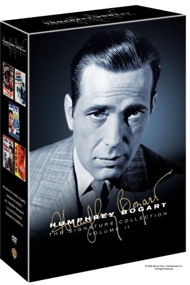
|
Warner DVD The Maltese Falcon, All Through The Night, Across The Pacific, Action in the North Atlantic, Passage To Marseille Starring Humphrey Bogart B&W 1:37 flat full frame Street Date October 3, 2006 59.98 the boxed set Reviewed by Glenn Erickson |
Humphrey Bogart is said to be the most enduringly popular movie star of all time, a claim that makes complete sense. When college-age kids first began to rediscover classic Hollywood in the middle sixties, Bogart was the first 'icon' to receive the official nod of approval. Warner Bros.' Humphrey Bogart The Signature Collection Vol. 2 gives us four DVD premiere titles and one fully restored, revisited classic that's well worth the sticker price. Bogie never looked better, that's for sure.
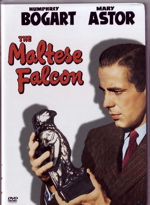
The Maltese Falcon
1941 / 100 min. /
Starring Humphrey Bogart, Mary Astor, Gladys George, Peter Lorre, Barton MacLane, Lee Patrick, Sydney Greenstreet, Ward Bond, Jerome Cowan, Elisha Cook Jr.
Cinematography Arthur Edeson
Art Direction Robert Haas
Film Editor Thomas Richards
Original Music Adolph Deutsch
Written by John Huston from the novel byDashiell Hammett
Produced by Hal B. Wallis
Directed by John Huston
A genuine miracle picture all around, The Maltese Falcon is a third attempt at Dashiell Hammett's detective story that gave Bogie a solid career boost as well as launching several character actors and John Huston as a major director. It was just in time for the incredibly lucky Huston; he entered the war years as a full writing-directing talent in his own name, instead of remaining the wildcat son of a show-biz acting family. The Maltese Falcon is also a solid step in the direction of the noir style, although its hardboiled pulp pedigree and the later noir mainstream are actually cats of a different stripe. Finally, Bogart's supreme personality glosses over what is really a stinker of a main character. That Sam Spade turns out to be a 'good guy' at the end is little more than a nod to commercial necessity.
The Maltese Falcon is another indicator of the rise of the writer-director hyphenate in Hollywood. Preston Sturges had just gotten started directing, and with this picture John Huston turned Hollywood moviemaking on its ear. His characters are pulled straight from Hammett's book yet are free of the stylistic restraints usually applied by the studios. The schemers aren't glamorized in appearance or habitat and the movie isn't laced with compartmentalized selling points -- no injections of 'comedy relief,' no musical interludes, no insulting sentimental back-stories to 'explain' the characters. No, audiences at The Maltese Falcon had to shut up and listen hard to keep up with its fast moving, smart talking storyline. The comedy bits come through the slightly stylized smart talk -- the dialogue is hardboiled, but nowhere near the calculated zingers that would come in pictures like Double Indemnity and Out of the Past. Bogart's Sam Spade doesn't sling quips to polish his ego, but to keep his opponents off guard.
This is Bogie's finest hour. Everything's in the dialogue, which leaves him little time for ticks and idle gestures. Look how many times in other movies he twitches or hikes his pants up, for want of something to do on screen. Bogart made impressions in previous pictures with his bedraggled face and haunted eyes, but here he gets a chance to really act, and he's terrific, plain and simple. Bogie benefited from the fact that audiences knew him mostly as a villain and were rooting for him to prevail his way; the ruthless quality of The Maltese Falcon looked much more credible than the fairy-tale idealism of something like The Roaring Twenties.
Huston gets away with allusions to sexual matters that the Production Code normally never allows. Hammett's provocative names remain intact: Wonderley (Wandering Lay) and Brigid (Frigid) are just as descriptive as Gutman (Fatso) and Dundy (Dunce). The Joel Cairo character would probably be pigeonholed as a pansy in 1941 terms, and is given a perfumed calling card for Spade to roll his eyes over. The obviously paranoid Wilmer (Wilma?) Cook is both passive and testosterone-challenged. He appears to be in an intimate relationship with Gutman and despite carrying two enormous pistols is repeatedly deprived of them without firing a shot. The film's biggest laugh comes when we're told that Wilmer shot an old man twice, but the guy could still knock him down and escape. Brigid's role in the caper is fairly explicit -- she seduces problem partners like Floyd Thursby and anyone else who gets in the way. If their target is 'playing for the other team,' Joel goes to work. In other words, the Gutman gang is a remarkable bunch of (in 1941 terms) sexual deviates. This isn't coded behavior, as Cairo demonstrates his oral fixation on a cane-head and openly spars with O'Shaughnessy on female terms -- scratching and kicking. "Oooh!"
When it comes to negotiating a double-cross Sam Spade can best of all of this riffraff put together. Spade sees through the pretense. He humors Brigid and bluffs Gutman, being careful never to reveal how little he knows of what's really going in. He has an advantage on the audience as well, as we have a hard enough time assembling the character of the opposition and are expected to take phonies like Miss Wanderley at face value, at least at first. The notion that the first interviewee is always lying wasn't the cliché that it is now, but we still fall for it.
Bogart's charisma glosses over the fact that Sam Spade isn't a standard good guy, and if we look at Spade's behavior for what it is rather than what Bogie makes of it, he's a complete heel. Spade's last-scene declaration of the Detective's Code is complete, self-serving baloney. His scruples about honor between partners are a joke when we remember that he had an affair with Miles Archer's wife Ida (Gladys George). In another exchange, his own secretary alludes to his skill as a ladykiller. Spade's first act after his partner is killed is to have the office signs changed. He openly admits that money can stretch his commitment to the law. For all we can see, Spade is quite willing to play along with his co-conspirators. He delights in shaking them down for money and may even be serious about setting up Wilmer as the fall guy, even though it later becomes clear that he's reserving Brigid for that honor. Spade is just as spellbound as the others as the Falcon is unwrapped, and only gets a 'noble' look in his eyes when the opportunity for a big payday vanishes.
As first explained by Julie Kirgo in Film Noir: An Encyclopedic Reference to the American Style, Spade is particularly sadistic with Brigid O'Shaughnessy. He sees through her fakery early on and spends the whole movie amused that she still thinks she's getting away with something. It's also implied that he sleeps with her. It's true that she's guilty and deserves to go to prison, but Spade derives entirely too much pleasure from turning her in, while enjoying the luxury of acting high-handed about it. He pretends he was honor-bound to deal out justice from the very beginning, when he was obviously a cynical player, careful to leave all options open.
Warners' DVD of The Maltese Falcon is a vast improvement on the very early first release disc that suffered from murky scenes, dirt and mottling, and frequent unsteadiness. Whether by a new transfer or digital cleanup all of the surface blemishes are gone and the unsteadiness has been reduced to a few uncertain frames in the opening titles. Savant jumped at a 'jump cut' (right after Cairo's tantrum over the unwrapped Falcon) and an apparent discontinuity (after the Brigid-Sam embrace in the last scene) but checked and found that they occur in the old version as well. Either the damage to the negative was done a long time ago (the first jump may have been a 1941 neg cutting error) or the film always had those minor stumbles.
The audio is much improved as well. Modern transfers obviously do the trick, but The Maltese Falcon was yet another classic that appeared for decades in lousy 16mm prints. If an improved transfer is reason enough to repurchase this title, the new edition merits the choice.
Warners has gone to town with the extras for The Maltese Falcon, which fill two additional discs. The main disc features a commentary by Bogart biographer Eric Lax, and has the welcome "Warner Night at the Movies" selection of extras that can be played in a block with the feature. They include a trailer for Sergeant York, a newsreel, and a grandiose ballet short subject The Gay Parisian directed by Jean Negulesco and choreographed by Léonide Massine. The Friz Freleng color Bugs Bunny cartoon Hiawatha's Rabbit Hunt and the Bob Clampett B&W Porky Pig cartoon Meet John Doughboy have racial stereotypes (and some fairly raw sexual innuendoes), yet play just fine without P.C. disclaimers.
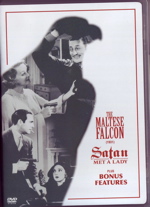
The second disc has the two earlier versions of Hammett's story, the 1931 The Maltese Falcon, a pre-code delight with its share of near-nudity. Leering Ricardo Cortez is a playboy detective hero and Bebe Daniels the duplicitous dame, but the emphasis is on whoopee fun time. The 1936 Satan Met a Lady (funny how that title wouldn't fly in today's neo-puritanical climate) has a grinning Warren William sparring with Bette Davis ... and it's not a great show for either of them. The two movies show how Hollywood did its best to convert The Maltese Falcon to standard entertainment fare.
Disc three starts with a good docu called The Maltese Falcon: One Magnificent Bird. A long list of qualified interviewees explain the show from all angles and chart the earlier versions, as well as give a nifty rundown on the legacy of Dashiell Hammett. Made by Leva Filmworks, the editing structure is for adults with normal attention spans, and the speakers are given the courtesy of communicating full thoughts instead of being chopped into six-word bites. A section of Humphrey Bogart trailers is actually a vintage Turner Classic Movies Becoming Attractions show, with a younger and thinner Robert Osborne hosting. An audio extra offers three different radio adaptations, two with some of the original stars and one with Edward G. Robinson. Finally, the 1941 Warner Blooper reel is a great opportunity to enjoy one's favorite stars screwing up and spouting profanity. Yes, James Stewart does know how to swear.
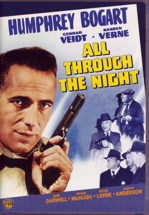
All Through The Night
1942 / 107 min. /
Starring Humphrey Bogart, Conrad Veidt, Kaaren Verne, Jane Darwell, Frank McHugh, Peter Lorre, Judith Anderson, William Demarest, Jackie Gleason, Phil Silvers, Wallace Ford, Barton MacLane, Edward Brophy, Martin Kosleck, Ludwig Stössel
Cinematography Sid Hickox
Art Direction Max Parker
Film Editor Rudi Fehr
Original Music Adolph Deutsch
Written by Leonard Spigelgass, Edwin Gilbert from a story byLeonard Q. Ross, Leonard Spigelgass
Produced by Hal B. Wallis
Directed by Vincent Sherman
Made before Pearl Harbor but apparently released afterward, All Through The Night is one of the last of the pre-war films with definite propagandistic intent. With Germany having overrun most of Europe there was no longer a great deal of opposition to Hun-bashing; Jack Warner had taken heat for Confessions of a Nazi Spy in 1939 but popular opinion had turned against the isolationists. All Through The Night takes a different route than earlier efforts to build public support against Germany. Sincere tragedies like So Ends Our Night confused and depressed people. Leonard Spigelgass' story is essentially a Damon Runyon-styled comedy that pits loveable fantasy gangsters against the more serious Nazi threat.
Patriotism takes many forms, and All Through The Night is a feel-good thriller with a mix of '40s trends. The basic form is a Damon Runyon tale not unlike Guys and Dolls, Lady for a Day or Little Miss Marker. Bogart's gentleman hood is a gambler, not a gangster, although his associates are all criminals. He also has a superstitious attitude toward his favorite cheesecake. Everybody is Gloves' friend; he's a big tipper. Of course, the fast talk and action are all in the service of a larger message, namely that the Nazi threat unites all Americans in the same cause. It's almost a joke when Gloves says that the Nazis won't let gangster Marty Callahan ply his trade; we all have to pitch in to make America's streets safe for American racketeering!
If there's any doubt that All Through The Night is a fantasy, Bogart's Gloves is both a tough guy and a dutiful son, always at his mother's beck and call. Jane Darwell is over the top with her "I've got a feeling, son!" sentiments but the story goes so quickly it's hard to take notice. Darwell had just won an Oscar for The Grapes of Wrath. She's continually asking where her son is, and we almost expect someone to tell her that Tom's gone over the hill, lookin' for an honest man or somewhere where a striker's gettin' his head busted in ...
The fun in All Through The Night is watching its incredible cast. Bogart is surrounded by comedians competing for joke space. Jackie Gleason and Phil Silvers put in early appearances while Wallace Ford and Edward Brophy crack wise on the sidelines. Frank McHugh whines constantly about his delayed honeymoon and William Demarest is Bogie's main sidekick. Demarest has some really demanding stunts; it really looks like he personally did the drop to the pavement from the swinging fire hose.
So many familiar faces walk into scenes, that if a genuine unknown showed up and started speaking lines, we get the feeling that the other actors would just stare at him and ask where he came from. The picture is one big actor's party and director Vincent Sherman's achievement is keeping things moving with up to seven or eight hams in the frame at any given time.
Peter Lorre continues with Warners by adding color to a standard Nazi wise guy thug, Pepi. Lorre's plastic face turns from giddy amusement to sober malice on a moment's notice; he may be the best thing in the movie. Conrad Veidt is the main bad guy and is mostly encouraged to be slippery and malevolent. Of all the escapees from the Third Reich, Veidt came the closest to being caught by the Nazis and is said to have donated most of his earnings to British relief in gratitude. He'd already made movies for Michael Powell and Emeric Pressburger in England and continued to play superb German villains as if repaying a debt. Also being villainous are the slimy Martin Kosleck and Judith Anderson, who is as usual extremely effective in a part below her talent. Kaaren Verne is the pretty heroine who has everything to offer but a truly memorable screen personality; she'd make a stronger mark when Kings Row was released.
All Through The Night shows how the war changed Hollywood action movies. The film uses violence and sadism without censor objections of the kind that hounded Warners' crime films only a couple of years earlier. An elevator fight sequence focuses on the possibility that Bogart might get his head crushed, and what amounts to a basic vigilante riot is endorsed because the targets are despicable traitors and foreign agents.
Besides its verbal quips and frequent slapstick action, All Through The Night also resembles modern action films. Gloves Donohue is the kind of two-fisted charismatic hero who makes jokes while dodging bullets. A couple of sequences seem to emulate Alfred Hitchcock situations from The 39 Steps and The Secret Agent, although the auction scene also seems similar to Hitchcock's later North by NorthWest.
Bogart naturally ducks the cops and personally foils the spies' Evil plot. The F.B.I. plays no role, indicating that All Through The Night was made before Washington got seriously into its wartime 'advisory' role. Like many early wartime films, the light tone when discussing concentration camps and whatnot may seem to be in bad taste. Later on, Hollywood 'morale' pictures were much more serious and message-bound. All Through The Night may not have the classic sequences of Alfred Hitchcock's Saboteur, but it's probably more entertaining overall.
Director Vincent Sherman recorded commentaries for all his movies before he passed away, and All Through The Night combines his memories with extra information from Eric Lax. Sherman is friendly but inaccurate in some of his observations, saying that a special effect was shot in Central Park and that an obvious rear projection is a scenic painting. Lax mostly sticks to dry reportage of the career arcs of all the supporting characters. Since there are so many of them the track fills up quickly.
The Night at the Movies extras are a Joe Doakes comedy short, the cartoon Lights Fantastic and a trailer for Gentleman Jim. The featurette Call the Usual Suspects is a lively discussion of character actors that makes little distinction between bit part players and bona fide stars (like Walter Brennan) with substantial supporting roles; it lets its interviewees float a lot of fuzzy ideas. Actor Bruce Davison tells us that Robert Aldrich advised him to become a character actor because they have longer careers and can always find work. In actuality, establishing one's self as a successful character actor in the old days was just as hard as being a star, only the reward was smaller. In Davison's time the odds were even worse -- after the studios dumped their stock companies, it was much cheaper to hire 'new blood' each time out than to pay for a familiar face. That's why movies today use a couple of stars and fill other roles with relative unknowns. There are now no 'character actors' in the old sense, just proto-stars either on the way up or on the way down.
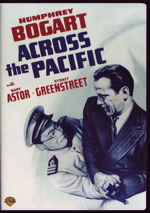
Across The Pacific
1942 / 96 min.
Starring Humphrey Bogart, Mary Astor, Sydney Greenstreet, Charles Halton, Victor Sen Yung
Cinematography Arthur Edeson
Art Direction Robert Haas, Hugh Reticker
Film Editor Frank Magee
Original Music Adolph Deutsch
Written by Richard MacCaulay from a story by Robert Garson
Produced by Jack Saper, Jerry Wald
Directed by John Huston
With America now in the war the studios rushed films into production, not knowing whether their young male talent would be called up for service. Across The Pacific was hastily thrown together and looks it; it recycles the secret agent formula so that Humphrey Bogart can thwart a Japanese bombing raid on the Panama Canal. Although more reserved than some independent productions encouraging Americans to get on the patriotic bandwagon, Across The Pacific's propaganda still outweighs its thriller value. Interestingly, Bogie's tainted hero is named Rick, while an undeveloped sidekick character played by Lee Fung Too is named Sam.
The kindest word for Across The Pacific as a thriller is "thin," although the return of Bogart, Astor and Greenstreet from The Maltese Falcon is still a pleasurable experience. They have some fun with seasickness and sunburn jokes and go through the motions of the espionage plot well enough. The real subject at hand is all too obvious: Japanese are treacherous murderers and different from us in every way. All Nisei (second generation Japanese-Americans) are loyal agents of the Emperor. Greenstreet's valet is a voyeuristic snoop and Victor Sen Yung's Joe squints through thick glasses while using jive-talk to express his attraction to white women. The film's attitude is that shooting is too good for these rats. The insistence on identifying its Nisei character as a deep-cover spy would seem to be a propaganda justification for arresting all Americans of Japanese descent.
The story is set right before Pearl Harbor and our two-fisted Bogart character single-handedly saves the day. As in the later James Bond thrillers, the bad guys routinely execute minor opponents but inexplicably leave the leading characters intact and lightly guarded, allowing Bogart to clean house without as much as mussing his hair.
A lot of the movie takes place on a Panama-bound steamship where we get to see the 'inscrutable" Japanese fight Judo-style and hear their alien poetry. Rick plays along and pretends that Ju-Jitsu is some kind of magic, but because 1941 films were not martial arts savvy, the only payoff we get is him dropping a Japanese opponent with one roundhouse haymaker. The Japanese are easily routed and Greenstreet's malevolent threat turns out to be a pushover.
It's either a hilarious true story or a lie too good to be discounted, but John Huston's account of the filming has become a Hollywood legend. Everybody breezed through the filming, as is evident by the lack of overall tension to the project that introduces and then drops interesting characters like Sam Wing On (Lee Tung Foo). Huston was awaiting a call-up for military service, and when his papers came through he left the film just as the last scene was being shot. Huston claimed that he purposely left the ending unwritten -- is that possible in the studio system? Bogart is in an impossible situation, tied up and surrounded by guards, with Astor and an old drunk character, neither able to help him. Replacement director Vincent Sherman, said Huston, didn't know what to do.
Imagining it as a John Huston prank, it all makes a good story. The situation isn't exactly one for Houdini; perhaps Sherman backed up a few shots and changed the setup so Bogart would have an easier time saving the day. We're convinced that Huston's attitude to the story can be summed up when Greenstreet and Bogie compare guns. "Mine's bigger than yours," grins Bogart.
Across The Pacific is not given a commentary, which is too bad as we'd rather have Vincent Sherman confirm or deny Huston's story then hear him saying how everybody got along so well on All Through the Night. The Night at the Movies has a newsreel about building a third canal lock and an expensive-looking Technicolor short Men of the Sky featuring strategic bombing advocate Hap Arnold giving out pilot's wings. The Draft Horse is a funny cartoon that basically says avoiding combat is a wise choice (!). The trailer this time is for Captains of the Clouds.
The featurette is about the patriotic Hollywood home front and can boast a welcome Joan Leslie interview. The Blooper reel is the usual star-spotting riot, with the jokes and the swearing getting a little more juicy than in the 1930s editions. Those must have been some parties.
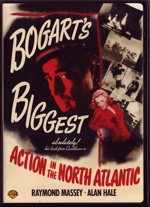
Action in the North Atlantic
1943 / 127 min.
Starring Humphrey Bogart, Raymond Massey, Alan Hale, Julie Bishop, Ruth Gordon, Sam Levene, Dane Clark
Cinematography Ted McCord
Art Direction Ted Smith
Film Editor George Amy
Original Music Adoph Deutsch
Written by John Howard Lawson from a story by Guy Gilpatrick
Produced by Jack L. Warner
Directed by Lloyd Bacon, (Byron Haskin)
By 1943 the Hollywood war effort had come up with movies to applaud the contributions of all services on all fronts, so much so that the British complained that it looked like WW2 was being fought solely by Americans. Action in the North Atlantic is a tribute to the Merchant Marine service that ferried precious cargo across the U-Boat-infested Atlantic to England and Russia. Of course, with Humphrey Bogart on board, a mostly defenseless Liberty Ship (an assembly-line freighter built at lightning speed) is shown fending off German attackers and even sinking a U-Boat on its own. By the end of the movie we might wonder why battleships are even neessary.
As its title promises, Action in the North Atlantic delivers wall-to-wall action. The real star of the show is the Warner Bros. special effects department, which swelled in size during the war to accommodate the need for footage of planes and boats in the height of battle. Although Republic still impressed with its often highly realistic car crashes, Warners' miniatures were the most extravagant. Jack Cosgrove was in charge of the work here but efficient workmen like Byron Haskin came out of the effects department to be directors after the war. In fact, it's said that Haskin took over direction on this movie after Lloyd Bacon walked off in a contract dispute. Future director Don Siegel is also on hand as an editor, cutting the crisp battle montages.
Nowadays the toy boats look exactly like what they are but audiences in 1943 loved the grandiose action effects. Howard Hawks' Air Force concludes with a fantasy battle in which Air Corps bombers are seen to sink an entire Japanese task force, all in miniature!
Action in the North Atlantic has plenty of miniatures but also received attention (and a big photo spread in Life magazine for its full-scale fire effects on a giant tanker set.
Future Hollywood Ten writer John Howard Lawson leans heavily on themes mandated by Government advisors. The Merchant Marine sailors are just as brave and valiant as men in arms and on average face more danger in their service. Experienced sailors are better used on the sea than in the infantry. The convoys are made up of ships from all our Allies, a veritable United Nations opposed to the Nazis. And the Russians are tough and loyal allies.
Bogart is mainly along for the ride on this one. The dialogue is intelligent and the crewmen well drawn (It is said that A.I. Bezzerides contributed additional dialogue). Team effort is emphasized over John Wayne heroics. The Liberty Ship is given a gun crew but Bogie doesn't turn into an anti-aircraft expert. A burial at sea stresses the ethnic makeup of the crew. Sam Levene is the 'sensitive' Jewish character, while Dane Clark is good as a troubled sailor. His slot in the Warners pantheon would soon be taken by John Garfield.
It's refreshing to see Ruth Gordon (Rosemary's Baby, Harold and Maude) as Massey's wife, although she isn't even given a name. Massey is just okay as the skipper; despite his efforts he seems a little too high-toned for the role. He was a strangely erudite draft-dodger bum in Powell and Pressburger's 49th Parallel, too. Julie Bishop barely registers as Bogart's unlikely girlfriend-turned-Missus. She's altogether too classy to be singing in a waterfront bar (voice courtesy Martha Mears) and the whole thing seems to be an excuse to sandwich Cole Porter's Night and Day into the show (and assure us that Bogie likes women).
But action is the thing here, with plenty of unlucky sailors being burned, bashed by falling airplanes or chewed up in submarine propellers. If I were considering joining the Merchant Marine and caught Action In the North Atlantic at a matinee, I'd head back to my job at the soda fountain.
Action in the North Atlantic looks fine all cleaned up on DVD. At over two hours, it was often dismembered for shorter television slots. This disc also has no commentary. The Night at the Movies show has another Negulesco musical short about a classy exhibition dancing team and a cartoon about a bait worm that acts like Jerry Colonna.
The featurette Credit Where Credit is Due extols the work of unheralded contract directors, mentioning mostly popular talents whose only crime is that they're not household names sixty and seventy years later. For instance, it tells us how Lloyd Bacon is undervalued, and then shows a scene from Golddiggers of 1933 that was almost certainly the work of Busby Berkeley. The extras end with a radio show version starring George Raft and Raymond Massey. I should listen to it to find out how a radio writer adapts an action-heavy movie with no key dialogue scenes.
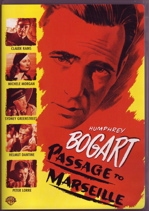
Passage To Marseille
1944 / min. /
Starring Humphrey Bogart, Claude Rains, Michèle Morgan, Philip Dorn, Sydney Greenstreet, Peter Lorre, George Tobias, Helmut Dantine, John Loder, Victor Francen, Vladimir Sokoloff, Eduardo Ciannelli
Cinematography James Wong Howe
Art Direction Carl Julius Weyl
Film Editor Owen Marks
Original Music Max Steiner
Written by Casey Robinson, Jock Moffitt from a novel by Charles Nordhoff and James Norman Hall
Produced by Jack L. Warner
Directed by Michael Curtiz
The Bogart set finally brings us to Passage To Marseille, a propaganda film from late in the war. This one may have good intentions and probably played well to wartime audiences, but it suffers greatly from an overload of propaganda. Critic James Agee expressed a lack of excitement over the film's standard patriotic stance and open contempt for one scene that endorses killing helpless Germans. Other critics complained that it was just too much noble chest beating for one movie, and it comes off as the least satisfying of the bunch.
As the synopsis above tries to explain, Passage To Marseille has a convoluted flashback structure that makes the whole movie play like a bedtime story: We know that the prisoners will escape, that Matrac will end up unjustly punished on Devil's Island, etc. This frees the movie to concentrate its efforts on pro Free French propaganda. As good as that aim is, the writing is laughable. The convicts include an ax murderer and Peter Lorre's safecracker, but they're all completely and humorlessly committed to patriotic values. Every decent Frenchman hates the Germans and despises the lickspittles and appeasers that sold their country down the Seine.
Working backward, it's easy enough to see that Passage To Marseille is an effort to portray France as a tireless and mostly united foe of Germany, to offset the popular image of a nation of appeasement, political scandal and petty corruption. If anything, Casablanca encouraged the former depiction. The lack of humor is the key, as later war-themed movies became more obsessed with Nazi and Japanese atrocities -- Objective, Burma!, Edge of Darkness. The sometimes-cynical jokes in earlier propaganda pictures afforded depth to unlikely characters and kept dialogue from being dominated by slogans and patriotic oaths. The classy handling of movies of this sort reached its zenith in Casablanca, of course. In Passage To Marseille everyone is motivated by a noble or sentimental cause and all of their dialogue relates to that theme. Bogart's Matrac hates Germans and has learned to hate France, George Tobias' Petit wants to kill all the Germans, etc.
If anything, Michael Curtiz' direction makes all of this too slick, like the extensive model work of the English countryside, with its (mostly) fanciful idea of a completely disguised combat airfield. Beautiful Michèle Morgan is Bogart's lost love, suffering nobly in flashbacks and looking ravishingly glamorous while hiding out the war in the French countryside.
Passage To Marseille probably did the trick as propaganda, as America bought its idea that 50 million Frenchmen were at heart members of the Resistance, that political unity and national pride burned in their hearts. The reality was that the politics of the country was a mess before and during the occupation. A large part of the resistance fighters were anti-Fascist Communists, people that neither De Gaulle nor the Allies wanted to encourage. Nonetheless, the cliché presented is that when brave American movie star pilots were shot down, they could always count on cognac and a kiss from a brave and sexy French girl.
It was typical in wartime propaganda to allow audiences to vent their frustration by offering immediate gratification on the screen: John Wayne would stare off-screen at the mutilated victims of Nazi or Jap(anese) slaughter, and self-righteously respond with a mini-bloodbath to square up accounts. Channeling the hatred of crowds is the stuff of lynch mobs, and Passage To Marseille offers a heinous example when Humphrey Bogart guns down the German airmen that bombed the ship. Victor Francen objects but it's obvious that we're meant to side with Bogie's righteous rage. The issue was debatable in 1944 but now seems almost beside the point, now that a majority of society passively approves of torture and atrocities when committed by the correct people.
The DVD of Passage To Marseille is slightly less clean than the other four titles but still looks great; old TV prints tended to be on the murky side. This title also has no commentary, but to help viewers understand the movie, Leva Filmworks has assembled a helpful mini-doc about the complicated political situation in France during the war. The experts interviewed lay out the basic setup clearly and without a lot of extraneous angles. Unfortunately, the budget obviously prevented the licensing of prime stock footage to illustrate the topic, and the show often cuts to generic war footage instead of something more relevant. DVD extra producers are too often forced to make do with very little.
The Night at the Movies lineup has an elaborate dramatic short I Won't Play. It's a showcase for actor Dane Clark and as such might have been a better extra for Action in the North Atlantic. An excellent musical short called Jammin' the Blues has a progressive style and features later Euro-film staple Archie Savage as (I think) a jitterbug dancer. The Weakly Reporter is a funny Chuck Jones cartoon with 101 wartime rationing jokes, and the trailer is for Uncertain Glory. This 1943 studio blooper reel is rather brief, and I wonder how many more years the practice was kept up. Offhand, I'd bet it stopped, along with a lot of other Warners social traditions, when the Unions came into the studios. The crews did without yearly parties, but were probably grateful that they no longer had to work 6 & ½ day weeks. And people wonder what unions were good for.
Humphrey Bogart The Signature Collection Vol. 2 ties one of Bogart's best to four wartime morale boosters that give plenty of insights on how Warners fought the Battle of Burbank. In addition to the extras noted above, each title is accompanied by its original trailer. Happily, these aren't included in the Warner Night at the Movies viewing option, and therefore don't serve as spoilers to the main feature.
On a scale of Excellent, Good, Fair, and Poor,
|
The Maltese Falcon rates:
Movie: Excellent Video: Excellent Sound: Excellent Supplements: Commentary by Bogart biographer Eric Lax; vintage newsreel, Technicolor musical short The Gay Parisian, cartoons Hiawatha's Rabbit Hunt and Meet John Doughboy; previous versions The Maltese Falcon (1931) with Bebe Daniels and Ricardo Cortez, Satan Met a Lady (1936) with Bette Davis and Warren William; Trailers. Documentary The Maltese Falcon: One Magnificent Bird, Humphrey Bogart Trailers, Breakdowns of 1941; 3 radio show adaptations including a version starring Edward G. Robinson. |
All Through The Night rates:
Movie: Very Good Video: Excellent Sound: Excellent Supplements: Commentary by director Vincent Sherman and Bogart biographer Eric Lax; Vintage newsreel, Joe Doakes comedy short So You Want to Give Up Smoking, cartoon Lights Fantastic, Featurette Call the Usual Subjects: The Craft of the Character Actor |
|
Across The Pacific rates:
Movie: Very Good Video: Excellent Sound: Excellent Supplements: Vintage newsreel, Technicolor short Men of the Sky, cartoon The Draft Horse. Featurette Hollywood Helps the Cause; Breakdowns of 1942 |
Action in the North Atlantic rates:
Movie: Very Good Video: Excellent Sound: Excellent Supplements: Vintage newsreel, musical short Cavalcade of Dance, cartoon Greetings Bait, featurette Credit Where Credit is Due, radio show with George Raft and Raymond Massey |
|
Passage To Marseille rates:
Movie: Good Video: Very Good Sound: Excellent Supplements: Vintage newsreel, patriotic short I Won't Play, musical short Jammin' the Blues, cartoon The Weakly Reporter; Featurette The Free French: Forgotten Unsung Victors; Breakdowns of 1944 |
Packaging: Six slim cases in card box Reviewed: October 12, 2006 |
Review Staff | About DVD Talk | Newsletter Subscribe | Join DVD Talk Forum
Copyright © DVDTalk.com All rights reserved | Privacy Policy | Terms of Use
|
| Release List | Reviews | Price Search | Shop | SUBSCRIBE | Forum | DVD Giveaways | Blu-Ray/ HD DVD | Advertise |





